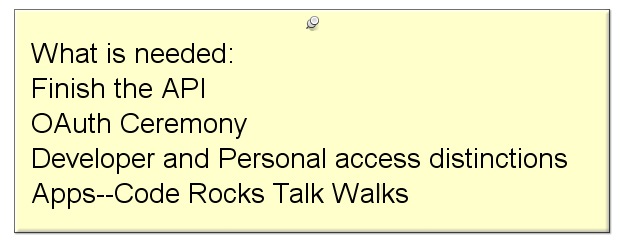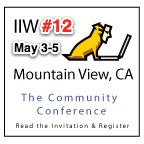VRM is starting to snowball. You can see it in the Twitter scroll there on the right, and in Twitter searches for #VRM. Gaining velocity lately is personal data. To look down that vector, I’ll connect several links.
The first is Show Us the Data. (It’s Ours, After All), by Richard H. Thaler in the New York Times. The gist:
The collection and dissemination of this information raises a host of privacy issues, of course, and the bipartisan team of Senators John Kerry and John McCain has proposed what it is calling the Commercial Privacy Bill of Rights to deal with many of them. Protecting our privacy is important, but the senators’ approach doesn’t tackle a broader issue: It doesn’t include the right to access data about ourselves. Not only should our data be secure; it should also be available for us to use for our own purposes. After all, it is our data.
Here is a guiding principle: If a business collects data on consumers electronically, it should provide them with a version of that data that is easy to download and export to another Web site. Think of it this way: you have lent the company your data, and you’d like a copy for your own use.
This month in Britain, the government announced an initiative along these lines called “mydata.” (I was an adviser on this project.) Although British law already requires companies to provide consumers with usage information, this program is aimed at providing the data in a computer-friendly way. The government is working with several leading banks, credit card issuers, mobile calling providers and retailers to get things started.
Here’s the long-form .pdf on mydata. What’s most important about it, especially for U.S. domestic purposes, is that its case is not just for protective legislation to keep customers safe from abuse by big bad companies, but for empowering customers in the marketplace. (When you dig into his work you see that this is Thaler’s case as well.) In this respect, mydata is a very VRM-ish move. But then, the U.K. government has been pro-VRM for awhile now. (Somewhere around here I have a link to a speech by a U.K. official that names VRM specifically. If it shows up, I’ll put it here.)
The good people at Ctrl-SHIFT, a U.K. company that’s highly active in the VRM movement, explains the mydata initiative:
The announcement is a first on two fronts:
1) Its ‘mydata’ programme encourages companies to release data they hold about individuals back to them, so that they can use this data for their own purposes. This is the first major Government initiative, globally, towards a changed personal data consensus: personal data is a personal asset, and individuals should have the right and ability to manage and use this asset to pursue their own goals.
2) The Government programme is also the first official recognition that there is a market for decision-making services (or ‘choice tools’ in Government parlance) that operates independently of existing markets for products and services – the market for what we call Personal Information Management Services (PIMS).
Want to know more?
Do you want to join your peers in debating this initiative and related issues? If so, then join our new Explorers Club on May 12 (in central London). It’s got a packed agenda including slots on both the Government’s new mydata initiative and on PIMS.
They also have a briefing paper on the topic.
Meanwhile, here in the U.S. we’ve been focused more on prophylaxis than empowerment, at least at the federal level. This is a problem with our obsession with privacy as an issue in itself. Focus on privacy alone, and conversation inevitably veers toward policy. What new laws and regulations do we need to protect ourselves? we ask. That may be a good question, but it ignores answers that are already coming from the marketplace — answers that see today’s privacy problems as secondary effects of market dysfunction, and which pursue opportunities that marginalize and obsolete today’s privacy-threatening business practices.
Rex Hammock deals with this in his post, VRM: I’ll show you mine if you’ll show me yours, which begins with a response to the same NYTimes piece:
…the examples of initiatives the writer points to may lead the reader to believe that government-led initiatives are the best route to take. That may be the best route one day, if companies don’t, themselves, join in the types of initiatives Project VRM is trying to foster.
However, it is important to recognize there are lots of startups, non-profits, academic and open source / grassroots (note: where I’ll place my bets) and even big-company initiatives in this arena, as well. It is also important to note that this issue is not something that sprang forth last week: For as long as I can remember, there have been those who embrace the internet, but who believe relationships (and identity) should belong to the users and buyers, not just hosts and sellers.
I will be writing more on this topic in the future. I just wanted to post this to alert people that the next big thing is not going to be about what others are doing to collect your data and lock you into their data-protectorates. The next big thing is going to be about you having better ways to access and use the relationships and data that belong to you, in ways that recognizes that markets are conversations — not plantations.
That last link is mine, pointing to an earlier post that unpacks the agricultural metaphor behind Rex’s point.
In vrm, fourth party and the empowered consumer, Gam Das gives a terrific example of VRM’s potential for radically improving the way markets work:
What appears to be missing is a service where vendors (manufacturers and retailers) are able to locate individuals looking for products that they might supply. Service Magic and Elance allow seekers to find providers in the Service space, yet nothing really exists yet in the consumer-product space.
vrm and the fourth party
The Fourth Party is a concept that has emerged from the VRM movement – it proposes a fourth party that acts on behalf of the Customer in the same way that a Third Party acts on behalf of the Vendor. If the Vendors are the hotel chains, airlines and car rental companies, then the third parties are Expedia, Orbitz andTravelocity and a fourth party might be the “agent” that negotiates with the travel aggregators to find the best deal.
The advantages to the customer of a four party system are huge and easily understandable. Booking my recent trip to Las Vegas involved a large number of parameters (flight times, airline options, hotel locations and star ratings, car rental companies and car sizes and above all the price parameters) – booking the trip took 3 hours and ended up with a deal for flight and hotel from Expedia and car from Hotwire. If there had been a service to whom I could have sent all the parameters and have them take care of it, then I would have paid for that and they would have probably got me a better deal if they do it all the time.
But wait… I remember a service like that from when I was a child, I think we called it a ‘Travel Agent’. But didn’t they become extinct a few years ago? Perhaps it’s time for them to re-emerge, but not only booking travel, but also handling all sorts of complex requirements, particularly bundles of goods and services. If enough people were able to publish their requests for things and there was a fee involved in finding a solution, a human outsource agent model is likely to emerge – something like the Dedicated Assistant service.
The fourth party also gets around the problem faced by Aggregators (such asKelkoo and Nextag) – to ensure that the consumer is presented with all the offers available. With a fourth party, their value will be to ensure this.
the future state
Once this starts to scale and requests are in millions and billions, then eventually the dedicated assistants will need to be augmented with more automated service that respond faster and are perhaps able to bid at auctions or take advantage of limited time / quantity deals, then my belief is that we will see Agent Technology doing our bidding online. I’ll be watching this space closely for many reasons.
Fourth parties are just one of the many VRM topics being tee’d up for IIW in Mountain View next week. It’s also one of the reasons why for the first time we’re inviting investors along with developers, journalists and other usual suspects. (The Ctrl-SHIFT people and Gam will be there, by the way, as will I.)
By the way, I wish I had involved myself in the Berkman Center‘s Rethink Music event this week (hard to do everything while writing a book), because EmanciPay (one of those potential IIW topics, above) would have been a great candidate for the new business model contest. (It got through two rounds of the Knight News Challenge, for whatever that’s worth.) In any case, I highly recommend reading the briefing book for the event. Here’s an idea to keep in mind: Once customers start driving the music industry bus, that industry will be much bigger than it ever was when the labels drove the thing.
And to loop back to the topic of this post, note the collection of entities in the Personal Data Ecosystem, which will also be well-represented at IIW next week.
 Craig Burton has a nice tutorial on developing VRM applications, using ListenLog as both an example and a challenge for next week at IIW.
Craig Burton has a nice tutorial on developing VRM applications, using ListenLog as both an example and a challenge for next week at IIW.


 Code talks, talk walks,
Code talks, talk walks,